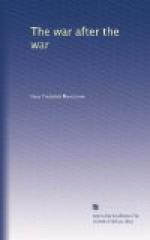Usually there is no limit to these National French loans. To be in France during the war and see the popular response to the appeal for funds is to have a thrilling experience in the practical side of patriotism.
I chanced to be in Paris when one of these loans was launched. Throughout a day of driving rain thousands of people stood in line at the post offices and private institutions waiting for a chance to put their money out to work for their country. The French wage worker, be he artisan or street cleaner, needed no coaching in the art of employing his funds safely and profitably. Just as saving is instinct with him, so is the putting of these savings out to work in a Government bond second nature. He is the thriftiest and most cautious investor in the world. He has established a close and confidential relation with his banker such as exists in no other nation. Therefore when the French financier offers him Government Bonds or “Loans of Victory” as the war issues are emotionally termed, he does not hesitate. He knows it is all right.
Alluring as is the possibility of profit in the new French Rente at the present abnormal exchange basis, it fades before the prospects for similar profit that lie in some of the Russian Government Bonds available in the United States. The Imperial Russian Internal Five and a Half Per Cent Loan of 1916 amounting to 2,000,000,000 roubles will illustrate.
Ordinarily the Russian rouble is worth 51.45 cents in American money. It has gone down to 32 cents. At this rate of exchange a thousand rouble bond bearing interest at 51/2 per cent would only cost $320.00. Based on the normal value of the rouble this bond would be worth $514.60 or $194.60 above the present price of the bond—an increase of about 60.8 per cent on the investment. Figuring roubles at the normal rate of exchange the yearly yield would be $28.28 or 8.8 per cent on the investment.
The fact that roubles are down so low is evidence that Russian credit at the moment is not as high as it might be. The principal equity behind this bond, as well as most other Russian securities available in America, is the fact that Russia has immense post-war possibilities. She will emerge from the conflict like a giant awakened and with the first realisation of her enormous undeveloped resources. To offset this, however, is the lack of stability of Russian Government as compared with the other Allies which makes all Russian Bonds speculative.
On account of the difficulty in shipping bonds and the preponderance of pro-Ally sentiment here, there has been a comparatively small market for German and Austrian war issues in the United States. Yet, in the face of these handicaps, a considerable market has developed. It is due to two definite reasons. One is the desire of the native born and transplanted Teuton to help his country. Many of them appear at the German banks with their savings books eager and ready to make financial sacrifice for the Fatherland. The other reason is that the German mark has so greatly depreciated (it has gone down from 23.82 cents to 17.65 cents) that should it ever come back to anything like normal and the Government does not repudiate its issues the investment will be very profitable.




